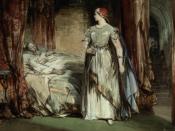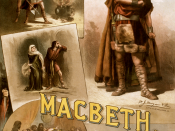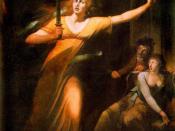The Macbeths' minds slowly deteriorate as more and more blood is shown. The blood shed in the beginning of the book was shown as an honourable act for the loyal soldier, Macbeth. Although, as time progresses, more blood is spilled; the murder of King Duncan reveals the true evilness of the couple. Later on, Macbeth and the Lady become more insane and Macbeth even kills his friend, Banquo and as for Lady Macbeth, her lunacy overwhelms her and she commits suicide.
There are images of blood through dead bodies on a battlefield at the start of the play. Indeed the spilling of blood is looked upon as an awful act; in this case it does not show Macbeth's ruthlessness, but actually shows how honourable and loyal Macbeth is to his king, Duncan. These bodies represent the greatness of Macbeth and how he is a strong powerful soldier:
Soldier: Which ne'er shook hands, nor bade farewell to him,
Till he unseam'd him from the nave to the chaps
And fix'd his head upon our battlements.
Duncan: O valiant cousin! Worthy gentleman! (1.2.23-26)
This quote shows how powerful Macbeth is and how much Duncan respects him. Duncan even praises Macbeth by calling him his "valiant cousin" and "worthy gentleman". Another quote that shows how respected Macbeth is, when Duncan gives the position of thane of Cawdor to him. "What he hath lost, noble Macbeth hath won" (1.2.77). This quote from Duncan furthermore shows Macbeth's greatness. Duncan even believes that where an ordinary man loses, Macbeth will win.
Images of blood are not shown as an honourable act like the previous example, but as a despicable one. As time goes by, Macbeth meets three witches. This is the beginning of the couples' mental degeneration. The three witches give Macbeth the prophecies about how...



This is sort of a rough
This essay is not that great. It's more of a practice. GO EZ!!!!
2 out of 4 people found this comment useful.